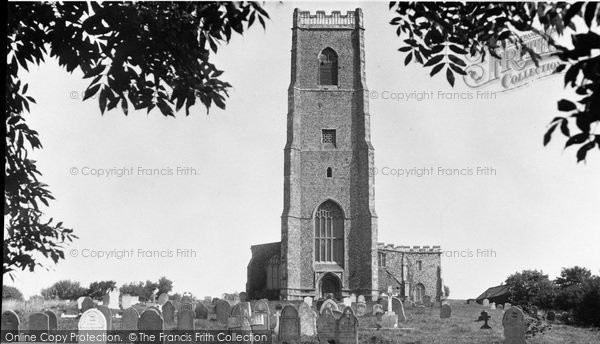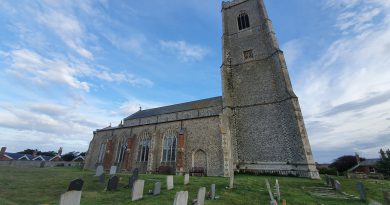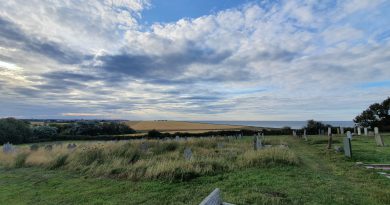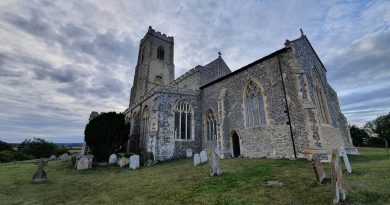Happisburgh – St. Mary’s Church
Located on a windy hill overlooking the North Sea, the current Happisburgh church was constructed in the fourteenth century and then finances allowed in the fifteenth century for a substantial rebuilding. There has though been a church here since the early Norman times and perhaps even the late Saxon period, with a few traces of early Norman architecture in the church tower.
The roof of the nave is slate, whilst the chancel roof is lead.
The north side of the church, which Household Words (a journal edited by Charles Dickens) said in the 1860s was “calculated to be engulfed [by the sea] before the close of the nineteenth century”. The church has avoided a watery fate, but the erosion issue was still of great concern in the early part of the twentieth century.
By chance, and I should try to ensure in future that this is more by design, I took a photo in nearly the same location as the marvellous George Plunkett. It’s evident that since his photo in 1977 that a few gravestones have gone missing from the churchyard, no doubt distributed around the exterior somewhere…..
The four-stage tower isn’t leaning, that’s just my photographic skills, and it was restored following the Second World War due to bomb damage. The church perhaps made itself a bit of a target to enemy bombers as there was a military aerial placed on top of the church tower, which is one of the highest in the county. Its height has certainly given it some trouble over the centuries, it has also been hit by lightning on numerous occasions with some considerable damage caused in June 1822.
In 1903, an architect was called as a substantial crack appeared in the tower and his report stated that the situation was “very serious”, which would certainly worry me if I was the vicar. The architect noted that “the walls consist almost entirely of flints and chalk lime mortar, and, the upper stages being comparatively thin for so lofty a structure, subject to the tremendous stress by winds and frost”. The church authorities would be pleased with his comments that a Victorian restoration of the tower likely saved it from destruction, but the architect’s suggestion of the addition of rolled steel joints in the structure that was now necessary must have been a worry financially.
The sizeable south porch.
The end chancel wall and this window led to a slight war of words in the local media in 1863. I moderately enjoyed going through the exchange, one reader called it “monstrous” and not holding back on his words, saying it was “a large blank space with a small window in the middle and a child would detect its glaring incongruity”. This caused John Henry Brown some problems, as he was the architect responsible for the west window and he wrote to the Norfolk Chronicle and stated that the Ecclesiastical Commissioners were responsible for the chancel end. He noted that the original reader’s comments had proved “injurious to my reputation” and wanted it clarified there were two different architects, for reasons no doubt seeming sensible to the church at the time. The original author wrote back to apologise for the lack of clarity and he compared the quality of the “beautiful restoration” of the west window and doorway to the “wretchedly mean restoration” of the chancel window, which is certainly a passionate argument to make.
In the graveyard is a memorial to those men lost on the HMS Invincible in a shipping disaster that took place in March 1801.
The church in 1955.












